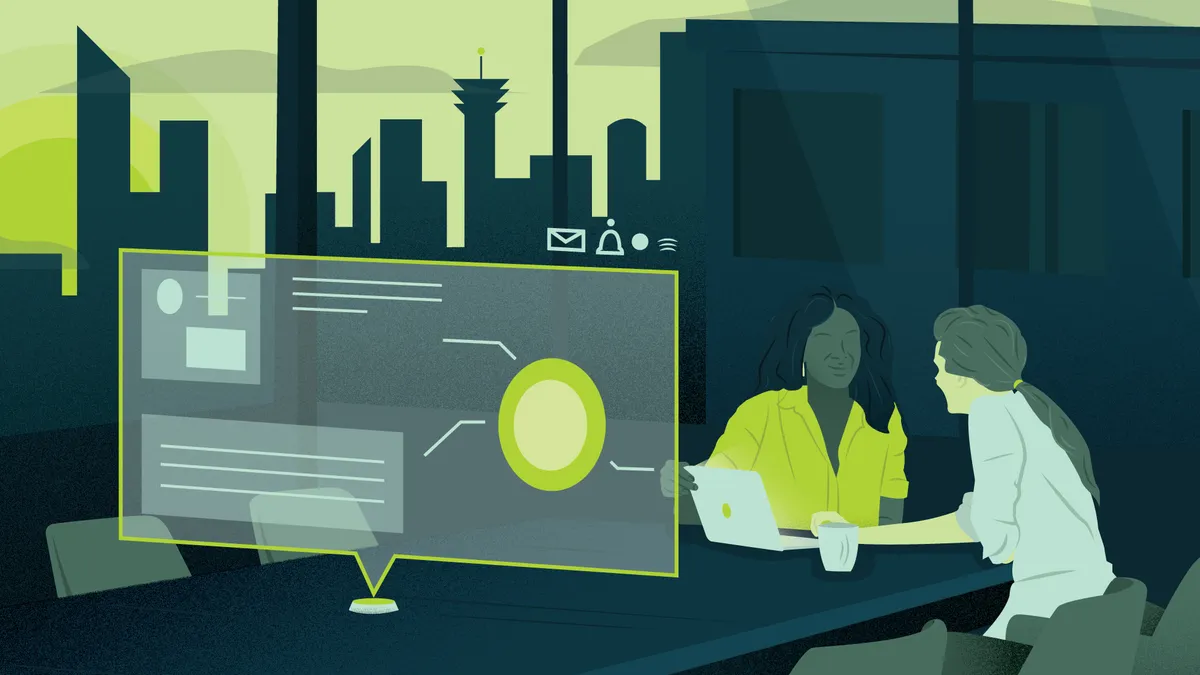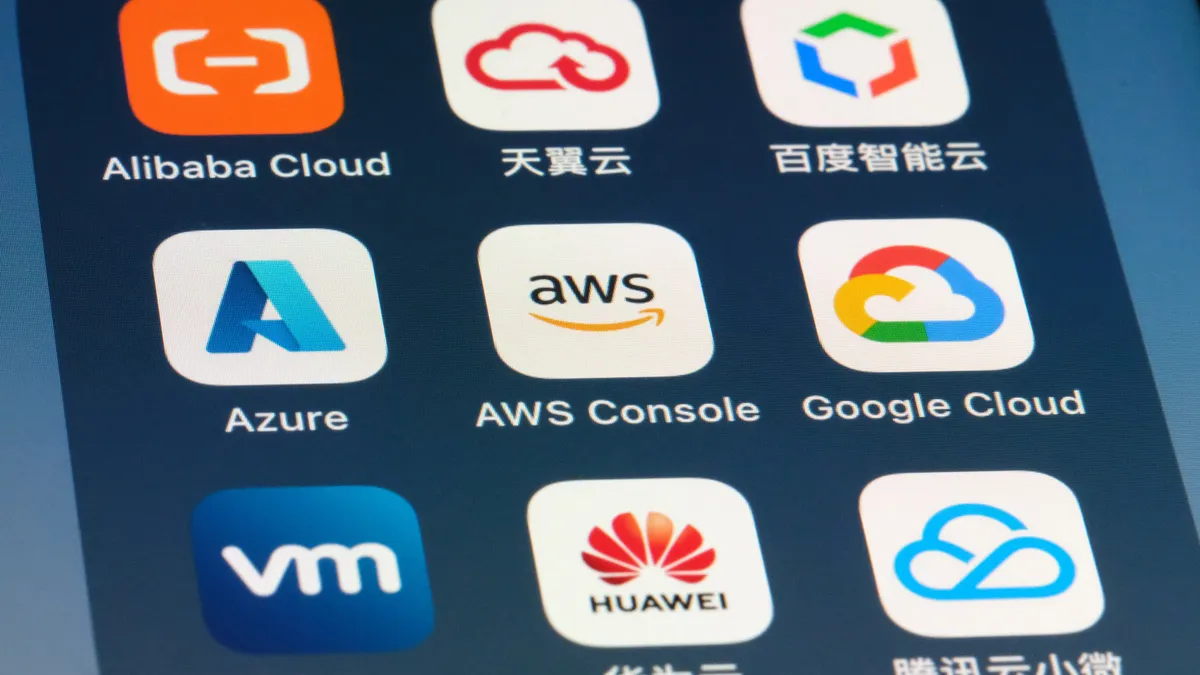Editor's note: This article originally ran in August. Because of its day-to-day relevance, we pulled it from the archives.
What's in a name? That which we call a industrial internet by any other name would smell as sweet — or, in the case of industry, return on investment.
The terms industrial internet, industrial internet of things and Industry 4.0 are often used interchangeably as umbrellas for the systems and processes they entail. Substance matters more than terminology, so long as technology implementers understand they are talking about the same thing.
For enterprises, the three terms can be considered synonymous.
In its basic form, industrial internet is "the application of internet technologies to industry," according to Richard Soley, executive director of the Industrial Internet Consortium (IIC) and chairman and CEO of the Object Management Group, in an interview with CIO Dive.
The industrial IoT is the backbone of industrial internet for many companies, collecting input from sensors to crunch data and drive business intelligence, while Industry 4.0 stems from Germany's strategic technology modernization plan, "Industrie 4.0."
In the short term, the manufacturing industry is facing the swiftest disruption from industrial internet, but use cases in healthcare, smart cities and supply chain management are also close on the horizon.
Companies that haven't gotten started yet may have missed the early mover advantage — even if they staved off burning their fingers like some early adopters — but if they don't get started soon they could find themselves too far behind, according to Soley.
The ideas behind industrial internet are old, but the drop in price of compute power and hardware made possible widespread modernization and digital transformation of centuries-old industries possible over the last few years.
Data analytics, supply chain optimization, robotic process automation and digital twins are also key capabilities that are increasingly wrapped around a company's physical product.
Though still in the early stages, the industrial internet is rapidly maturing. Since becoming an area of evaluation in 2016, today the space has analytics and AI/ML systems, disappearing IoT and data silos, robust APIs and a variety of vendors, many with clear specialization, according to Forrester. And after spurring the public cloud and building out their infrastructure, vendors have refocused on the public cloud as their customers continue moving to it.
The tortoise's race to win
Industrial internet solutions can be as big as connecting every piece of equipment in a production plant through sensors to seemingly innocuous things, such as lighting.
Current, powered by GE, is a startup that joins efficient solutions like LED lights to software to create a smart business environment. Commercial real estate is one of the biggest opportunities for internet-connected technologies, Chief Revenue Officer Deron Miller told CIO Dive in an interview.
Adding sensors to a lighting system can optimize business space and efficiency. But the challenge can be convincing new customers that haven't tied IoT, software and data into systems like lighting. Before you can implement, you have to prove the ROI and business investment, he said.
Trying to win in-demand cybersecurity, data analytics and AI experts, industry has to battle the perception of not being a "sexy" space.

John Miller
Council director, MAPI
While many "lighthouse" examples of industrial internet projects are in place, a relatively small number of organizations are moving past the pilot phase or running large parts of their organization on the industrial internet. There's no one-size-fits-all solution, and starting from the ground up can be time- and cost-intensive.
But it's the tortoises race, not the hare's. Companies will have to test out a solution in one team or facility before rolling out to the rest of its operations — and be cognizant that failure is a possibility because it is an important element of success, Soley said.
Getting started, the point isn't "I want an IoT solution," according to Paul Miller, senior analyst at Forrester Research, in an interview with CIO Dive. Going in with such a mindset can lead to more failure than success by ignoring the important stakeholders and objectives.
Clamping sensors on a machine or throughout a factory isn't going to serve the business, but a strategy to identify what the problem is, how it will be solved and what is needed can distinguish between a factory full of stuff and an IoT environment serving the business, according to John Miller, council director of the Manufacturers Alliance for Productivity and Innovation (MAPI), in an interview with CIO Dive. IoT is one answer, but it must work in tandem with other capabilities, especially data analytics.
Companies starting out can work with organizations like MAPI or IIC to get in touch with other companies that have tried things first, experts and resources. IIC, for example, offers testbeds to help companies develop new industrial internet technologies.
Disruption in the business model
Moving to the industrial internet isn't as straightforward as replacing a server. Many industrial players grew accustomed to investing in a few pieces that would run for decades, but now they also have to pay attention to the software and digital services space, according to Paul Miller.
This is shifting the sales model away from a few multimillion dollar pieces of hardware to scores of software and services applications: It may be less sexy, but it is more compatible with the digital economy. For vendors, success falls to a combination of innovation, breadth of capability and a wide partner ecosystem, according to Paul Miller.
Interoperability between systems has been emerging as a growing priority. Since few players will offer end-to-end solutions, it's important for businesses to be able to run solutions from different industrial internet providers in tandem.
This is shifting the sales model away from a few multimillion dollar pieces of hardware to scores of software and services applications: It may be less sexy, but it is more compatible with the digital economy.

Paul Miller
Senior analyst, Forrester
Many customers would like to choose the application they want; if a different vendor has better software than their sensor provider, a system that is open at the top will allow them to pick the tools that best suit their needs, according to Deron Miller. The data and what is done with it is what's important, and APIs are a crucial tool to afford this flexibility.
Companies like Siemens, Phillips or GE are trying to tie the whole product lifecycle together, but the risks of too much proprietary tech is imminent, he said.
The business opportunity trickles down to workforce opportunity too. Siemens has seen an 80% growth in its digital business over the last three years, and with the IoT integration services market expected to triple by 2025, is expecting to capture more growth down the line, according to CEO Joe Kaeser in a statement provided to CIO Dive. The company is planning to hire 10,000 workers to meet integration demands in the next seven years.
The biggest problems are talent and security
The talent wars are acutely hitting the industrial space. Even with the best tools and technology in the game, unless a company has the team to make sense of the data and apply it, real change and advances may not happen.
Trying to win in-demand cybersecurity, data analytics and AI experts, industry has to battle the perception of not being a "sexy" space, according to John Miller. With many facilities based in rural areas, drawing talent out of urban areas and technology hubs proves a challenge.
Even with comparable compensation, this is pushing many companies to reconsider incentive packages and benefits to attract and retain talent. High turnover rates in the space have hit the companies that spend a lot of money training a new hire, according to John Miller.
The ideas behind industrial internet are old, but the drop in price of compute power and hardware made possible widespread modernization and digital transformation of centuries-old industries possible over the last few years.

With AI and data analytics workers in high demand, filling open positions through traditional pipelines can quickly prove difficult. Companies don't have to drag their heels just because expertise is lacking. The best way to build expertise is to build test beds for systems in question, according to Soley.
Talent problems are followed close behind by security. Industrial internet is all about adding more sensors and data points in a company to improve efficiency and productivity, but more digital endpoints means more vulnerability to a crippling attack.
Perimeter security through firewalls isn't enough, according to Soley. Understanding system robustness, control, access and technical security is crucial to protect the expensive and extensive being put in place.






















